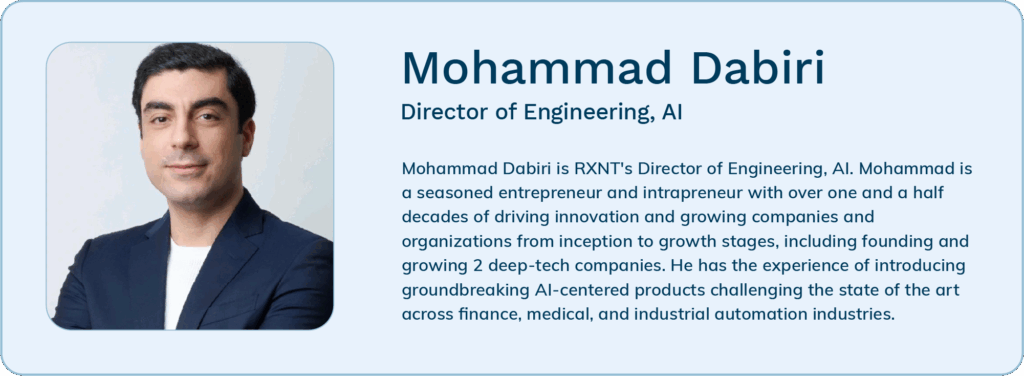AI-powered ambient listening is transforming day-to-day documentation workflows for clinical providers. Here’s what you need to know before trying it for your practice.
In a world where documenting a patient visit can take longer than the visit itself, ambient listening technology is doing more than lending a hand—it’s redefining how care is delivered. In 2024 alone, the ambient listening market size reached 1.27 billion and is projected to surge past 9.37 billion by 2033—marking the end of an era where documentation takes precedence over patient care.
That’s why we’re launching Ambient IQ—our new, natively built, HIPAA-compliant, AI-powered tool that streamlines documentation for physicians, providers, and their practices. Gone are the days of excessive note-taking, late nights, burnout, and scheduling backlogs, with physicians reporting a reduction in documentation work by up to 70%.
The Basics of Ambient Listening
How does ambient listening differ from other documentation methods?
Think about the first few moments after you walk into the exam room. You’re greeting the patient, ensuring privacy & getting cleaned up, then heading to the computer to confirm their identity and begin documenting their concerns. It’s a divided experience, switching between the patient and the screen(s) throughout the visit.
Ambient listening technology changes that routine—more often than not, for the better.
With ambient technology, you simply start a session on your device and let AI handle the documentation and encounter generation in the background, so you can stay focused on the patient.
One provider we spoke with shared what his process looked like before switching to ambient listening:
“When I brought a computer into the room, I would just focus on the computer and barely look at the patient. Then, there would be times when I’m [focusing on] the patient, but then I have to leave, run to a computer, and put all the orders in before I’m onto the next patient.” – Dr. Craig Sorkin
If you’ve ever felt like Dr. Sorkin—spending more time with your screen than your patient—it might be time to rethink your documentation strategy.
How does ambient listening work?
There are many ambient scribe solutions on the market, and while not all are built equal, many begin with the same core functionality: passively recording and transcribing patient/provider conversations.
Recording is commonly carried out via a mobile device, such as a phone or tablet, because it can be more easily positioned between a provider and patient to capture accurate audio. However, some tools also allow providers to record via a laptop or desktop computer, either through built-in microphones or accessories attached to the device.
When a provider completes a recording session with their ambient software, the audio is transcribed and converted into the appropriate template or note format—similar to the transcription functionality available in popular video conferencing platforms like Zoom. However, the AI software used for ambient listening is more advanced—it typically has a greater knowledge of clinical terms and concepts and is trained to produce a SOAP note or other specialty-oriented template, rather than a simple summarization of the conversation.
Ambient listening tools can be used as part of an integrated software suite or as a supplementary tool to an external system. For example, Ambient IQ was built in-house as part of RXNT’s EHR, allowing it to automatically create clinical encounters from the notes it produces, ready to be signed. Similar functionality is available in some EHR systems through third-party integrations rather than a natively built tool, so your results may vary. That’s why it’s important to understand how the tool you choose has been developed!
For physicians who don’t need a comprehensive EHR or who use one that isn’t directly compatible with an ambient assistant tool, providers in need of clinical AI can opt to use a standalone ambient listening solution. Generally, users will copy and paste the note output of the ambient software into their records system. While not as seamless, this can still be an effective method to gain the benefits of an ambient scribe in your day-to-day workflows, which is why RXNT offers Ambient IQ in both integrated and standalone options for customers and non-customers alike.
How to Help Patients Feel More Comfortable With AI
In 2024, we asked 700 patients if they would be comfortable with their providers using AI tools in their work—only 37% of them said “yes.” Today, that number has shifted as AI becomes more ingrained in our everyday lives.
In fact, many patients actually prefer to see their providers investing in their well-being by utilizing new technologies. Here’s what one RXNT provider had to say about it:
“I had been using [RXNT] for e-prescribing, and Ambient IQ is the reason I chose RXNT when I decided to start using EHR. I trust it to see things from the physician’s perspective. It has had a huge impact on my ability to chart quickly and efficiently. Plus, it is kind of fun. My patients enjoy seeing me use new technology. In fact, when I bring my phone into the room with Ambient IQ on it, I tell them we have new technology while smiling, and it sets the right tone. It allows me to have the visit without dividing my attention with technology, which no one likes.” – Dr. James Brewer
Since some patients are undoubtedly still hesitant about AI and the usage of AI by providers, there are a few ways you can help alleviate their concerns.
#1: Get Patient Consent
One of the most important elements of any patient-provider relationship is trust. To build trust with patients around the use of ambient listening software, it’s important to be transparent about its use and consistent in your communication. While consent forms may satisfy some legal requirements, trust requires more than a signature.
Here’s some example language you can use when gathering patient consent:
Please note: This is an example, and is provided for informational purposes only and does not constitute legal advice. Consent requirements may vary under state and federal law.
“I’d like to use a tool called Ambient IQ during our visit. It records our conversation and creates a draft visit note, which I’ll review for accuracy after our visit. The recording is automatically deleted, and your information remains private.
This tool helps me take notes so I can stay more present and focused on you during our visit.
Is it okay if I use Ambient IQ for this and future visits? You can tell me to stop using Ambient IQ at any point.”
#2: Emphasize Privacy, Security, and Compliance Protocols
It’s challenging to deliver exceptional care and earn patient trust if you’re uncertain that your software tools are secure and HIPAA-compliant. That’s why it’s essential to invest in reputable software solutions that make data safety a top priority. Your patients will appreciate the knowledge too.
The best ambient AI solutions have three things in common:
- All data is encrypted in transit and at rest with end-to-end encryption.
- Only authorized team members can access PHI, and access is limited to only crucial information.
- Patient recordings are only stored for a short period of time, then automatically deleted once they’ve served their purpose.
Other areas of security to focus on, if you can find a solution like RXNT’s Ambient IQ solution:
- It’s HIPAA-compliant by design
- It’s powered by Microsoft Azure and Google Cloud, with HIPAA-compliant data centers
- It never uses your patients’ PHI for training purposes
- The entire company passes background checks and receives annual HIPAA & security training
- Continual testing and vulnerability scans are performed to identify and fix risks
- All vendors handling PHI are HIPAA-compliant and sign BAAs
When speaking with your patients about their data, addressing the areas above will give them peace of mind and help build confidence that your tools are private, secure, and compliant.
#3: Share the Benefits From the Provider Perspective
If you’ve invested in AI, your patients are probably already seeing many of the benefits firsthand: shorter wait times, fewer scheduling hiccups, more face-to-face time with their provider, and better appointment follow-ups. What they may not have witnessed are some of the “behind-the-scenes” benefits that make providers’ lives easier.
According to Medical Economics, the time providers spend in their EHR documenting patient visits ranges from 3.5 and 6 hours daily, often cutting into “pajama time.” We recently spoke with a provider who was spending 12-15 hours a week outside of normal office hours, just to keep up with daily demands. Now, with the help of AI, she’s cut documentation back by 70%!
When she began using Ambient IQ, she shared with her patients how much time it gave her back in her evening schedule—time she could spend with family and friends instead of documenting care. Knowing that it helped her be a better provider and be more present in her personal life, her patients were highly supportive.
When patients see that technology is supporting their provider, it reinforces trust. Additionally, ambient scribe tools enable providers to be more present with their patients, ultimately enhancing patient satisfaction.
How to Get Providers Onboard with AI?
Not only do your patients need to be on board with your adoption of AI, but so does your team. Here are a few ways you can make the transition as seamless as possible:
- Provide initial and ongoing training sessions for your team to make sure they’re confident and comfortable using the technology.
- Encourage them to use AI for time-consuming administrative tasks, but not for clinical decision-making.
- AI significantly reduces time spent on administrative tasks, so make sure your team knows it.
- Introducing new platforms can make documentation overwhelming. Consider the systems you already have, and see if they have AI capabilities or if AI can be integrated.
- Feedback is a powerful tool to ensure a smooth adoption process. Ensure you continually ask your team for it and make changes where necessary.
Documentation Like You’ve Never Experienced Before
Artificial intelligence tools—such as ambient listening—are becoming increasingly common in healthcare, and providers who adopt them today will be well ahead when they become the new standard soon enough.
Ready to invest in the power of AI? Visit https://www.rxnt.com/ambient-iq/ to join the waitlist and learn more about how RXNT’s integrated Ambient IQ solution can elevate your practice.
More AI Resources to Explore:
- A Guide to Getting Started With AI in Healthcare
- Bridging the Digital Divide: How to Get Patients on Board With AI
- AI in Action: How Artificial Intelligence is Shaping Healthcare Today
- Myths Vs. Reality: The Truth About AI in Healthcare





